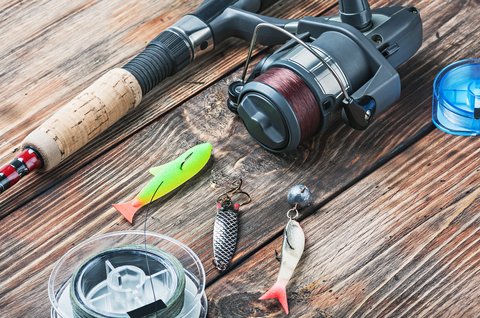Largemouth bass fishing anglers are overwhelmed with lure choices when they enter a sporting goods store. There are hundreds upon hundreds of baits to choose from. With so many choices, how do you know when to use a particular type of lure?
Choosing the right bass lure depends heavily on the type of bait and the conditions under which you will be fishing. Understanding the strengths and weaknesses of the various types of bass baits will help you decide which to use.
Here is a rundown of five types of bass lures available and when you should consider using them.
Spinnerbaits
Among the most versatile of all bass baits are spinnerbaits. They can be used throughout the bass fishing season and are particularly good when fishing heavy cover, because in comparison to other baits, they rarely get hung up.
ALSO READ: 3 Go-To Lures for Early Spring Bass
Spinner baits are especially suited for shallow water and for fishing along drop-offs. They have a reputation for taking big largemouths, in part because they can be fished in heavy cover, where other lures may fail.
Crankbaits
Along with spinnerbaits, crankbaits are among of the most versatile of all bass lures. They will take fish consistently throughout the season, under most conditions.
One of the benefits of the crankbait is that is can be fished quickly, which allows you to cover a large area of water in a short amount of time; helping you locate feeding fish, with minimal effort.
ALSO READ: How to Custom Modify Your Bass Baits
The downside of crankbaits is that they are not very good for heavy cover. They easily hang up on weeds, logs and other cover, which can lead to considerable frustration.
Plastic Worms
The plastic worm has been a staple for largemouth anglers for decades. It is reliable and effective, especially when the action seems a bit slow. Plastic worms can trigger strikes when nothing else seems to be working.
ALSO READ: 5 Places to Find Bass on a New Lake
They can also be fished in a variety of conditions, from shallow water to deep, and can be presented using a wide range of setups.
The downside of plastic worms is that they tend not to work as well when bass are highly active or when the water is particularly cold, say less than 60 degrees.
Jigs
Like plastic worms, jigs are best fished slow. They are often good for luring fish from heavy cover, but they can easily become hung up on that cover.
Jigs take accurate flipping skills to fish them properly along the edges of heavy cover. They work well throughout the year, but tend to be more effective in warmer water conditions.
Topwater baits
Arguably, topwater baits can be one of the most exciting ways to take largemouth bass. They are primarily effective during the summer months, when largemouth bass are looking for prey, such as frogs and other critters on the surface.
ALSO READ: 3 Topwater Baits to Use in Cold Weather
Topwater baits may not consistently take fish throughout the season, but they do have their moments. Some of the best times to use them are in the low-light hours of dawn and dusk, especially when the surface is calm.
© Oleg Doroshin | Dreamstime.com – Fishing tackle








